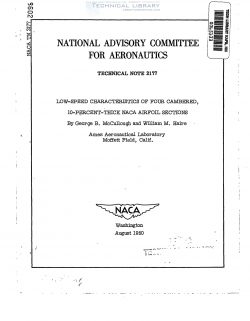naca-tn-2177
- Version
- 45 Downloads
- 1.23 MB File Size
- 1 File Count
- December 12, 2016 Create Date
- December 12, 2016 Last Updated
National Advisory Committee for Aeronautics, Technical Notes - Low Speed Characteristics of Four Cambered, 10% Thick NACA Airfoil Sections

A two—dimensional low—speed investigation was made of four thin,
cambered airfoil sections. The airfoil sections were the NACA M10,
9. = 1.0; the 6M810, a = 0.8 (modified); and the NACA 0010 cambered to
the same two mean lines. The data, obtained for Reynolds numbers of
3.7 x 106 and 5.2 x 106, include measurements of lift, drag, pitching
moment, and chordwise distribution of pressure. The effect of surface
Eggghness was investigated as well as the effect of a split flap deflected
It was found that the NACA four—digit—series sections developed
greater maximum lift than the corresponding NACA 6hA—series sections
for all test conditions. The maximum lifts of both series without '
flaps were reduced by surface roughness; the effect was greater for
the sections with the smaller amount of camber. The increment of maxi—
mum lift produced by the split flap deflected 60° was greater for the
NACA four—digit—series sections.
Visual observation of tufts attached to the upper surfaces of the
models indicated that the stall of the sections cambered for an ideal
lift coefficient of 0.3 was the result of separation of flow from the
leading edge almost immediately after the appearance of turbulent separa—
tion at the trailing edge; whereas, for the sections cambered for an ideal
lift coefficient of 0.8, turbulent separation from the trailing edge pro-—
grassed as far forward as the 70—percent—chord station before laminar
separation appeared near the leading edge.
As part of a general study of the stalling characteristics of thin
wings, a two—dimensional investigation was made of the effect of a large
change of airfoil thickness distribution on the low—speed stalling char—
acteristics of cambered airfoil sections. Specifically, the basic thick—
ness distributions compared were 10—percent—thick NACA four—digit and
Glut—series sections. Calculations based on the method described in refer—
ence 1 indicate that differences in the high—speed characteristics of sym-
metrical conventional and low—drag airfoil sections tend to disappear when
these sections are cambered by combining them with the same NACA a—type
mean line. If there is little or no difference between the two types of
cambered airfoil sections from the standpoint of high—speed'drag, the
choice of section for aircraft employing cambered wings probably will
depend on the low—speed stalling characteristics. For this reason, it
seemed desirable to compare the characteristics of typical sections at
low speed.
| File | Action |
|---|---|
| naca-tn-2177 Low Speed Characteristics of Four Cambered, 10% Thick NACA Airfoil Sections.pdf | Download |
Comment On This Post